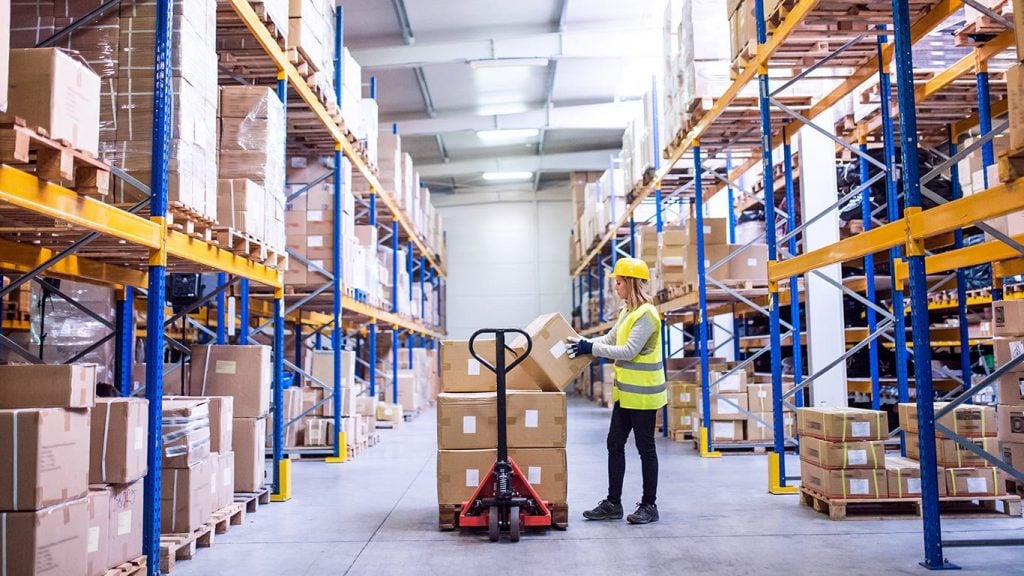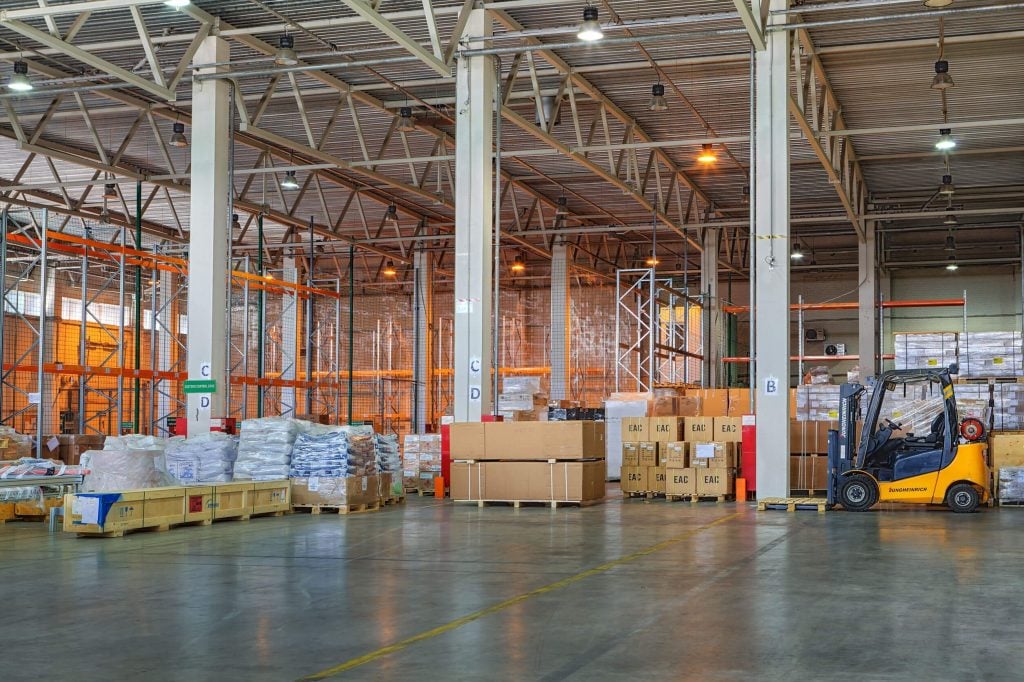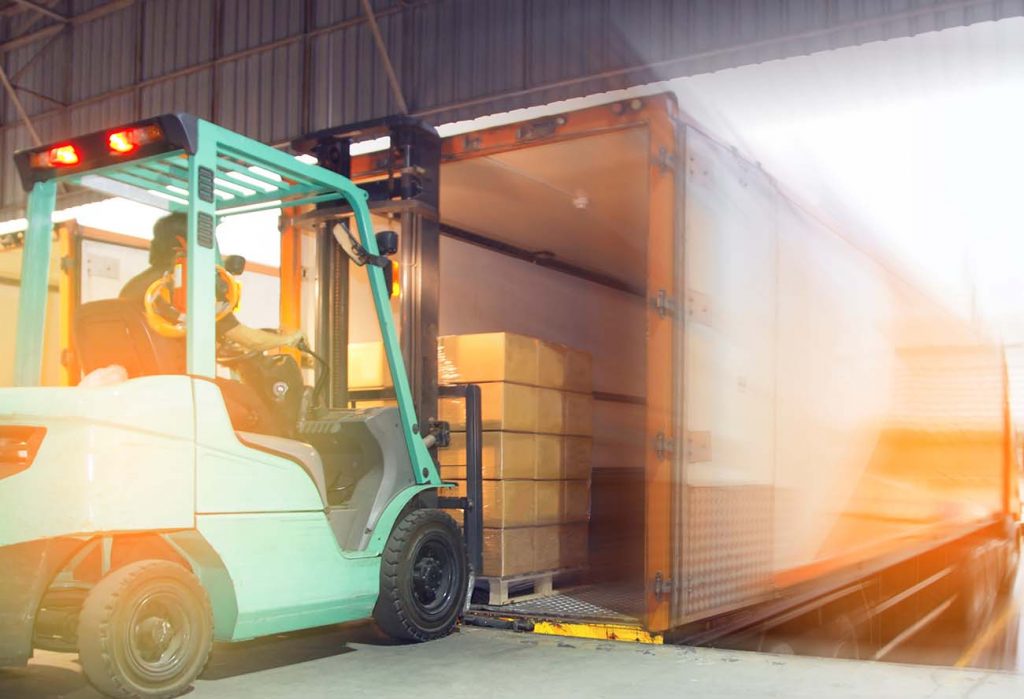Warehousing is an essential component of your retail supply chain. While it isn’t the most exciting topic, warehousing and inventory storage have an impact on everything from procuring raw materials and properly managing inventory to sending orders to consumers on time.
Though warehouse fundamentals haven’t changed much throughout the years, warehousing solutions have.
With new technology, urbanization, and the ever-expanding world of online shopping, storage has never been a more hotly debated issue — so much so that there is a lack of warehouse space and on-demand warehousing is on the rise.
Now, let’s check out what is warehousing in logistic management!
Table of Contents
What is Warehousing? Definition of Warehousing
Warehousing is the act of keeping items for subsequent sale or distribution. While a small, home-based firm may store items in a spare room, cellar, or garage, bigger enterprises often own or rent space in a structure intended expressly for storage.
Another meaning of warehousing is that the procedure of storing physical products in a specialized warehouse or storage facility until they are sold or dispersed. Warehouses keep things safely and securely in an orderly manner, allowing you to trace where they are stored, when they arrived, how long they have been there, and the quantity on hand.
Inventory warehousing may be done from home for small or young firms until they exceed the area. At that moment, a company must rent storage space, lease a warehouse, or outsource logistics to a third party in order to store merchandise in their warehousing facilities.
This is all about warehousing meaning in logistic!
Warehousing types and functions
A warehouse is a location used for the storage or accumulation of products. The storage function may be carried out successfully with the assistance of warehouses used for keeping commodities.
Warehousing is also described as the acceptance of responsibility for the storage of products. Warehousing generates temporal utility by keeping items throughout the year and releasing them when needed.
So, what are the warehousing types and functions?
Warehousing functions
Storage
This is the fundamental purpose of warehousing. Surplus items that are not required right away might be kept in warehouses. They may be provided to consumers as and when they are required.
Stability of prices
Warehouses play a vital part in the price stability process. It is accomplished by the establishment of temporal utility through warehousing. Prices of commodities are reduced when supplies are plentiful, while prices are raised when supplies are few.
Avoiding risks
When commodities are housed in warehouses, they are vulnerable to a variety of dangers such as theft, degradation, exploration, fire, and so on. Warehouses are built in such a way that these dangers are minimized. When products are housed in warehouses, a bailment contract is in effect.
The individual storing the items in warehouses is known as the bailor, and the warehouse keeper is known as the bailee. A warehouse keeper is responsible for taking reasonable care of the items and protecting them from different threats. The warehouse keeper is answerable to the owner of the goods for any loss or damage to the items.
Financing support
Loans can be obtained from the warehouse keeper in exchange for the owner’s products. The warehouse keeper is protected by the goods. Banks and other financial institutions will also make loans based on warehouse revenue. In this way, warehousing serves as a source of funding for business owners to satisfy their operational needs.
Packing and grading
Warehouses nowadays provide packaging, processing, and grading services for commodities. According to the owner’s directions, goods can be packaged in handy sizes.
Types of Warehousing
Private warehouses
Private warehouses are built and owned by businesses in order to store their items. These are owned and utilized solely by the manufacturers and are not intended for use by other manufacturing or commercial entities.
Because of the high cost of building and maintenance, the number of these warehouses is fairly minimal. Such warehouses can only be afforded by large corporations.
Public warehouses
These are also referred to as duty-paid warehouses. A public warehouse, often known as a duty-paid warehouse, is one that is available to the general public. Most businesses, particularly those on a small and medium scale, cannot afford to build their own warehouses due to the significant financial commitment required in their development and upkeep.
They make use of these warehouses, which may be held by an individual or an organization whose main goal is to provide storage facilities to individuals for a fee or charge. These warehouses adhere to the government’s norms and regulations.
Public warehouses are extremely beneficial to company owners. These warehouses are typically located near railway lines or major thoroughfares in order to provide speedy transportation services. Goods stored in a warehouse can be hypothecated to banks and other financial organizations in order to get a loan or other financial help.
Because of the newest mechanical equipment employed in handling and maintaining the commodities, public warehouses provide improved security and handling of commodities. In the warehouses, goods can be branded, graded, and packaged in appropriate sizes.
Bonded warehouses
Bonded warehouses are used for imported products that are denied clearance due to the importer’s failure to pay customs duty. These warehouses are typically located near ports. Customs taxes must be paid before goods can be taken from these warehouses.
Bonded warehouses can be operated by the government or by private companies (when granted licenses to operate such warehouses). Customs officials exert stringent control and oversight on their operation and functioning in both circumstances.
The importer has some control over his goods and may inspect and check them whenever he wants. After paying a share of the customs charge, commodities can be taken from these warehouses in proportion.
Goods stored in these warehouses may be branded, packaged, graded, labeled, and canned on-site. Bank loans can be obtained by using the receipts produced by these warehouses as collateral security.
There is little chance of products being exposed to theft, damage, or degradation. The entrepot trade, or re-export of imported commodities, is substantially aided because the importer may have items delivered without paying any custom duty.
Warehousing risks and benefits
Of course, anything in this world has benefits and its drawbacks, so as warehousing. Do you want to find out what is the warehousing risks and benefits are? Let’ check it out right away!
Warehousing benefits
Production support
Production support that is timely and consistent may significantly minimize your production lead times. For example, at ShapeCUT, this business has the warehousing capacity and transport logistics experience to safely keep your precision-cut steel components until you need them. And when you do, those critical components are supplied where and whenever you need them, whether that’s the same day or the next.
Opportunity to grow your business
How can you grow your business? Focus on your primary business: making your products.
Of course, you can only focus if you are not constrained by the necessity to keep all ingredients, components, and completed items at your production plant. Outsourcing storage and delivery to a warehouse or distribution center allow your company to better utilize existing space for product development and process optimization.
Processing and packing
Warehouses and distribution centers now do a lot more than just store your merchandise. A good warehouse will offer services such as picking, packaging, and shipping, as well as inventory management.
Price leveling off
Warehousing maintains a consistent supply of products into the market by storing commodities when supply exceeds demand and then releasing them when demand exceeds just-in-time production. Consistent stock levels serve to keep pricing steady, making it easier for firms to anticipate output, profit, and loss.
Obtaining funding
Because the business owner may borrow money against the security of the materials or items in the warehouse, using a warehouse can help with your financing arrangements. Then, bonded warehouses have some extra benefits, which are government-licensed institutions that accept imported products for storage until customs tax is paid. Storing imported products or materials for export in a bonded warehouse aids in cost management by paying customs duty appropriately.
Stocking on the spot
This benefit is especially beneficial for enterprises that make seasonal items. Spot stocking is another storage strategy used in the agriculture industry. Instead of using a warehouse facility year-round or shipping directly from the manufacturer, spot Stocking employs a number of warehouses at the same time in a variety of locations near major markets to decrease travel time and satisfy customer requests promptly.
Reduce company risk
Goods stored in a warehouse are insured at the warehouse owner’s risk. Storing products in an off-site warehouse reduces inventory loss due to theft, fire, and damage, and shifts this risk to the warehouse. It is their insurance claim, and any compensation will be paid by the warehouse insurance company.
Warehousing risks
Physical Exertion
Warehouse employees frequently have to handle big, bulky products, which can cause varying amounts of physical strain over time. Physical strain, on the other hand, might be difficult to detect because each worker’s body is unique. It is impossible to estimate how long a person will be able to tolerate extended exposure to physical labor.
Using machines in warehouse
Warehouse machinery has the potential to be quite harmful if not used properly by your staff. Many machines include moving elements that might cause significant accidents if proper safety precautions are not taken.
Loading and unloading of vehicles
Warehouse employees are frequently required to load and unload products. This may cause many accidents. Some of them can be list as pinned in between forklifts, loading dock, truck, van… Or maybe some unsecured items, trucks, falling dock plates will hit them.
Objects falling
Items are prone to falling and injuring your squad. Furthermore, objects stacked high can hit your employees when they move them from one location to another. Again, they may easily fall off and cause damage.
Harmful substance exposure
Toxic compounds are a severe occupational danger. Cleaning supplies, however, have the potential to damage your team if you do not protect them properly.
Inadequate safety training and knowledge
As you may have seen while reading this post, one of the most important strategies to limit the risk of dangers is to instruct your staff on suitable safety practices. As a result, poor safety training is a major risk in and of itself. If your team is not operating in a safe manner, any of the other threats will be more likely to cause an accident.
Falls, slips, and trips
This danger is one of the most prevalent causes of workplace accidents. They can be caused in a warehouse by:
- The floor is littered with substances such as packing debris and beverages.
- The flooring is slick.
- Cannot see the hidden steps and ridges.
- Areas with poor lighting.
- Random boxes on the floor.
6 Popular warehousing services of warehousing companies
Warehousing is a critical service that enables firms to manage the delivery of goods to customers. Nonetheless, warehousing entails more than merely storing products in a warehouse. Most warehouse companies also provide the following additional services:
Order Processing
A company that operates a warehouse might provide order fulfillment services to its customers. Order processing, packaging and labeling, and shipment are all included. Businesses utilize order fulfillment to cut operational expenses involved with maintaining their own infrastructure, focus on core tasks, and reach customers through many channels.
Inventory Management
Businesses can employ warehousing services to keep track of their goods. A corporation, for example, can use warehouse cycle counts to assess the delivery of items to customers. With this knowledge, the same corporation may take action to increase its cycle count. Inventory control also allows businesses to easily remove and decrease receiving mistakes.
You can also check out our inventory management services. We provide Odoo open-source – this software that have the inventory module will help you track any details, data about your inventory in real-time.
Contract warehousing
Contract warehousing is a service provided to businesses who want to construct distribution facilities in certain locations. This implies that a company may build up a warehouse overnight and begin distributing items to customers within a few days. This service might last for months or years. It is popular among startups and fast-growing enterprises. These businesses may lack the financial means to establish their own warehouses. Furthermore, constructing a warehouse from the ground up takes time. In today’s competitive business climate, organizations must contact their customers as quickly as possible before competitors enter the same area.
Cross docking
Cross docking, in a nutshell, allows clients to transport products from one or more manufacturing facilities to a strategically situated distribution hub. In most situations, these facilities are placed close to the end-users. When items come from production locations, they are divided into many shipments before being distributed to customers. Manufacturers who lack the physical space, equipment, and manpower necessary for customized order fulfillment might benefit financially from this service. This is in addition to manufacturers who require bulk cargo unloading and merging.
Transportation
A warehouse company might also provide transportation services to its customers. Depending on the demands of the client, this might include ocean, rail, road, or air transportation. Some organizations that provide this service enable their customers to trace the transit of items from one place to another in real-time. This service can be the difference between a small business’s or startup’s success or failure.
Loading and unloading
Transloading is the movement of products from one means of transport to another, such as from a truck to an airplane. Some warehousing companies provide this service to their customers.
A Guideline examples of warehousing strategy
There are plenty of tactics about warehousing. However, we will list some strategies of warehousing that you might use. We hope that these warehousing examples will help you build your own strategy for your own business. Therefore, let’s move on to find out what these popular strategies are!
Value centered and customers focused
To keep up with the ever-changing objective known as consumer demand, businesses must include flexibility into their warehouse operations so that they can provide clients with whatever and whenever they want it. Specially, in today’s competitive market, “product customization” has emerged as a new emphasis and vital function of contemporary warehouses.
Leading practices organizations, in fact, use the warehousing phase as a “last opportunity” to gratify their consumers and stay ahead of the competition. As a consequence, they’ve found a number of approaches to increase product customization potential in the warehouse. Prevalent solutions include introducing value-added services into warehouse operations, such as compliance labeling or floor-ready packaging, as well as deferring final assembly until the warehouse phase.
Postponement at the packaging, product, and circuit board levels provides three chances to manufacture “special” versions of the company’s fundamental products while maintaining buffer stock to a minimum.
Simultaneously, best-practices organizations increase product delivery by using virtual warehousing and reimagining warehouses as knowledge hubs for the whole supply chain. Because of the rising emphasis on value-added services, many businesses are redefining their warehouses as profit centers rather than cost centers.
Unite warehousing operations
Many corporations have realized that the economic benefits of combining several warehouses into a single large facility after decades of decentralizing. Then, tiny regional warehouses near local markets were established. Warehouse centralization minimizes operational costs by reducing the number of facilities a firm must manage as well as the number of goods it must carry.
Many businesses save money early in the consolidation process by picking central warehouse facilities that offer the best combination of land, labor, and transportation costs. Others reduce shipping expenses by collaborating with efficient carriers and teaming with the centralized warehouse. Leading practices firms also prioritize the development of a centralized information system to enable reliable data collecting in the consolidated warehouse.
Design a versatile warehouse
Many top practice firms have been particularly interested in investigating novel designs that incorporate flexibility into warehouse operations in recent years. Built-in adaptability enables warehouses to make the greatest use of space and maintain smooth work flow, assisting warehouses in meeting ever-changing consumer needs for new and improved products.
Leading practices businesses employ a “team-build” approach to warehouse design, including all departments involved from the outset, including engineering, information systems, finance, marketing, customer service, buying, manufacturing, and warehouse operations. They also alter the block arrangement as needed to ensure that items move efficiently through the warehouse.
Many businesses also utilize simulation modeling to test multiple potential designs before settling on the one that offers the most flexible interaction of warehouse equipment. Other businesses utilize ergonomic concepts to tailor warehouse designs to various sorts of workers, understanding that a well-designed workspace boosts worker productivity.
>> Read more: Inventory Management Strategies – The magic tool to organize your warehouse management
Take advantage of a warehouse management system
Most warehousing businesses rely on the correct warehouse management system (WMS) software to connect production, scheduling, shipment planning, and order fulfillment systems. Leading practices firms take care to deal solely with WMS providers that have experience in the best warehousing tactics for their sorts of warehouses, independent of the vendor’s understanding of the company’s vertical business.
WMS, as an execution system, controls warehouse resources like as space, manpower, equipment, tasks, and material flow in order to transfer goods to market as effectively as possible. Furthermore, when integrated with automatic identification and data-collection technologies like as bar coding and radio frequency data communication systems, the WMS transforms into a powerful inventory-tracking tool.
Furthermore, WMS reduces downtime in the warehouse by alerting warehouse managers and employees to jobs that may be “interleaved”. Then, it completed concurrently or in fast succession. Many businesses boost supply chain efficiency by combining WMS with other logistics technologies such as order management systems (OMS) and transportation management systems (TMS) (TMS). The integrated solutions not only increase warehouse productivity, but also improve vendor-customer communication and delivery accuracy.
Choose your own warehousing strategy and control your inventory!
Well, that’s it! You have known all about the warehousing and also anything related to it. So, in this final words, we just recommend you to keep your business under control. It means that you warehousing strategy and your inventory management, too!
Make sure that you have a system to track all of these. Otherwise, you can check out our services which is Odoo. This system have both warehousing mangement and inventory mangement odoo. This might be the best solution for you.
And yet, don’t forget to comment below if you have any questions for us. We will give you the best solution that we can. Furthermore, you can subscribe to us so you can get the notice about warehousing or any topic related!
Thank you for reading.

























